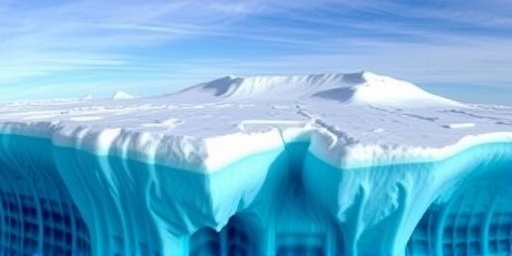A groundbreaking study from the National Oceanic and Atmospheric Administration (NOAA) has unveiled a stark reality: Antarctic ice shelves are melting at a rate 50% faster than previously predicted, dramatically accelerating sea level rise and endangering millions in coastal regions worldwide. This revelation, based on satellite data and advanced modeling from 2015 to 2023, underscores the escalating urgency of combating climate change through immediate global emission reductions.
- Thwaites Glacier’s Accelerated Collapse Signals Tipping Point
- Coastal Cities Face Imminent Flooding Risks from Surging Seas
- Ocean Warming Drives Unprecedented Antarctic Ice Shelf Erosion
- Global Experts Rally for Drastic Emission Cuts Post-NOAA Report
- Projections Demand Immediate Innovation in Climate Resilience
The research, published in the journal Nature Climate Change, analyzed the Thwaites and Pine Island glaciers—often dubbed the ‘Doomsday Glaciers’—and found their disintegration is outpacing forecasts by a significant margin. Lead researcher Dr. Sarah Jenkins from NOAA’s Arctic and Antarctic programs stated, ‘What we’re seeing isn’t a distant threat; it’s happening now, with ice loss rates surging due to warmer ocean currents undermining these massive shelves.’ This accelerated Antarctic ice melt could add up to 0.5 meters to global sea levels by 2100 under current emission trajectories, far exceeding earlier estimates.
Thwaites Glacier’s Accelerated Collapse Signals Tipping Point
At the heart of NOAA’s findings is the Thwaites Glacier, a colossal ice mass roughly the size of Florida spanning over 192,000 square kilometers in West Antarctica. The study reveals that between 2020 and 2023, surface melting on Thwaites increased by 70% compared to the previous decade, driven by record-high ocean temperatures infiltrating beneath the ice shelf. Satellite imagery from NASA’s GRACE-FO mission corroborates this, showing a loss of approximately 150 billion tons of ice annually—equivalent to the weight of 500 Empire State Buildings.
Experts attribute this rapid ice melt to ‘marine ice cliff instability,’ a process where exposed ice cliffs collapse into the sea after the protective shelf thins. Dr. Jenkins elaborated in a NOAA press briefing, ‘The warming Southern Ocean is the culprit, with temperatures rising 1.5 degrees Celsius since the 1980s, eroding the glacier’s grounding line faster than models anticipated.’ This isn’t isolated; adjacent glaciers like Pine Island are experiencing similar fates, with calving events—massive icebergs breaking off—occurring at twice the predicted frequency.
The implications for Antarctica are profound. If Thwaites fully collapses, it could destabilize the entire West Antarctic Ice Sheet, potentially unlocking enough ice to raise sea levels by 3 meters over centuries. NOAA’s data indicates that current melt rates could contribute 10-15 centimeters to sea level rise by mid-century alone, a figure that aligns with IPCC warnings but surpasses optimistic scenarios.
Coastal Cities Face Imminent Flooding Risks from Surging Seas
The accelerated Antarctic ice melt is not a remote polar issue; it’s a direct harbinger of peril for coastal populations. NOAA’s projections highlight that cities like Miami, New York, and Shanghai could see chronic flooding events increase by 300% within the next 30 years due to this heightened sea level rise. In the U.S. alone, over 13 million people live in areas less than 1 meter above sea level, putting assets worth $1.5 trillion at risk.
Take Miami, for instance: The city has already endured ‘sunny day’ flooding 400 times more frequently than in the 2000s, and NOAA’s models predict an additional 20-30 cm of rise from Antarctic sources by 2050. ‘We’re talking about submerged neighborhoods, disrupted infrastructure, and economic losses in the billions,’ warned FEMA administrator Deanne Criswell in response to the study. Globally, low-lying island nations like the Maldives and Kiribati face existential threats, with entire communities potentially displaced as sea levels encroach on their land.
Beyond immediate flooding, the study points to secondary effects: saltwater intrusion contaminating freshwater aquifers and eroding beaches that serve as natural barriers. In Bangladesh, home to 160 million people, the Ganges Delta could lose 17% of its land to sea level rise by 2050, exacerbating poverty and food insecurity. NOAA emphasizes that these threats are amplified by storm surges, as seen in Hurricane Ian’s 2022 devastation in Florida, where higher seas worsened inundation by 20%.
- Key Vulnerable Areas: Southeast U.S. coast, Pacific islands, and Southeast Asian deltas.
- Economic Toll: Projected $500 billion in annual global damages by 2100.
- Human Impact: Up to 200 million climate refugees by century’s end.
Mitigation efforts, such as Dutch-style sea walls and mangrove restoration, are underway, but experts agree they’re insufficient without curbing the root cause: anthropogenic climate change.
Ocean Warming Drives Unprecedented Antarctic Ice Shelf Erosion
Delving into the mechanisms, NOAA’s research pinpoints ocean warming as the primary accelerator of Antarctic ice melt. The Southern Ocean has absorbed 90% of excess heat from greenhouse gas emissions, with surface waters now averaging 0.2 degrees Celsius warmer per decade. This heat penetrates deep under ice shelves via upwelling currents, melting them from below at rates up to 100 meters per year in vulnerable zones.
Historical context reveals a troubling trend: Since the 1990s, Antarctic sea ice extent has declined by 12% per decade, contrary to earlier stability assumptions. The study’s use of ice-penetrating radar and autonomous underwater vehicles provided unprecedented data, showing basal melt rates 50% higher than 2010 predictions. ‘Climate change is supercharging these processes,’ noted co-author Dr. Michael Meredith from the British Antarctic Survey. ‘Emissions from fossil fuels are trapping heat that directly assaults the ice.’
Furthermore, atmospheric changes play a role. Reduced ozone levels and shifting wind patterns have increased warm air incursions over the continent, contributing to surface melt ponds that darken the ice, reducing its reflectivity and amplifying absorption of solar radiation—a feedback loop intensifying the ice melt cycle.
- Primary Driver: Circumpolar deep water intrusion under shelves.
- Secondary Factor: Air temperature anomalies up 2 degrees in West Antarctica.
- Amplifier: Albedo feedback from meltwater pools.
This convergence of factors explains why the 50% faster melt rate caught researchers off guard, prompting a reevaluation of global climate models.
Global Experts Rally for Drastic Emission Cuts Post-NOAA Report
The NOAA study’s release has ignited a chorus of calls from international climate experts for aggressive action. At the recent COP28 summit in Dubai, UN Secretary-General António Guterres referenced the findings, stating, ‘Antarctica’s cry for help demands we phase out fossil fuels without delay. Sea level rise from this ice melt isn’t negotiable—it’s inevitable unless we act now.’
Scientists from the Intergovernmental Panel on Climate Change (IPCC) echoed this, warning that limiting warming to 1.5 degrees Celsius could cap Antarctic contributions to sea level rise at 0.3 meters by 2100, but current policies project 2.5-3 degrees, risking catastrophe. Renewable energy advocates, including the International Renewable Energy Agency (IRENA), highlight that transitioning to 80% clean energy by 2030 could avert the worst outcomes.
In policy circles, the European Union has pledged an additional €10 billion for Antarctic monitoring, while the U.S. under the Inflation Reduction Act is investing $370 billion in green tech. However, challenges persist: Developing nations argue for financial aid from high emitters. Dr. Jenkins urged, ‘The time for half-measures is over; we need binding global agreements to slash emissions 45% by 2030.’
Grassroots movements are also mobilizing, with protests in major cities demanding accountability from oil giants. The study’s virality on social media has amplified public awareness, potentially swaying voter sentiment ahead of key elections.
Projections Demand Immediate Innovation in Climate Resilience
Looking ahead, NOAA’s models forecast that without intervention, sea level rise from Antarctic ice melt could reach 1 meter by 2100, submerging 1,000 kilometers of U.S. coastline and displacing 10 million Americans. High-emission scenarios paint an even grimmer picture: up to 2 meters, overwhelming current defenses.
Innovation offers hope. Emerging technologies like floating barriers around glaciers and geoengineering proposals, such as ocean alkalinity enhancement to cool waters, are gaining traction. International collaborations, including the Antarctic Treaty System’s new research initiatives, aim to bolster data collection with drone swarms and AI-driven predictions.
Communities are adapting too: Singapore’s $100 billion coastal protection plan includes artificial reefs and elevated infrastructure. NOAA recommends prioritizing nature-based solutions, like restoring 1 billion hectares of wetlands globally, which could sequester carbon and buffer against rises.
Ultimately, the path forward hinges on collective will. As Dr. Jenkins concluded, ‘This study is a wake-up call—curtailing climate change through emission cuts is our best defense against the rising tide from Antarctica’s melting heart.’ With diplomatic summits looming, the world stands at a crossroads to safeguard future generations from this accelerating crisis.









